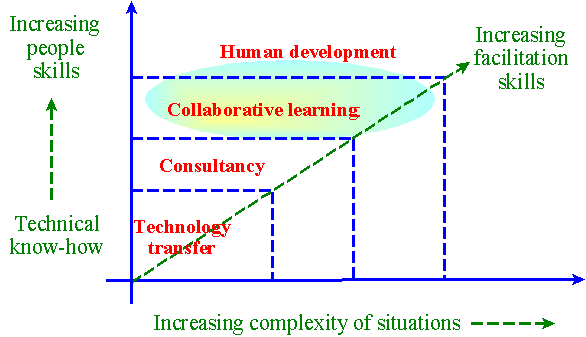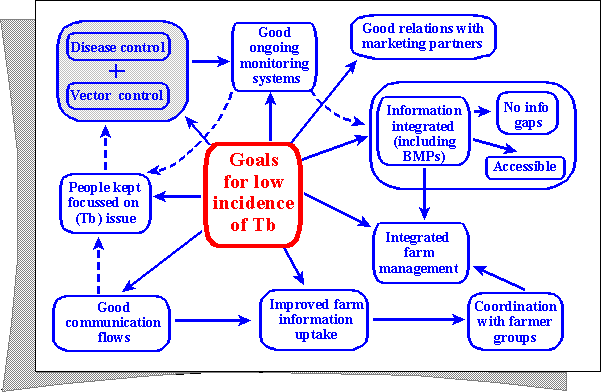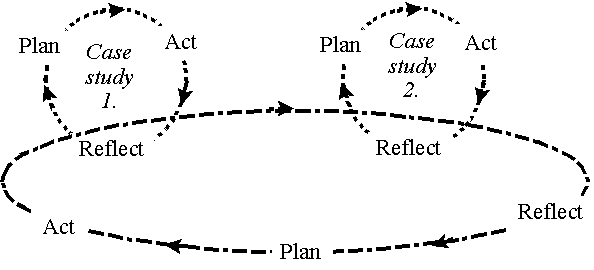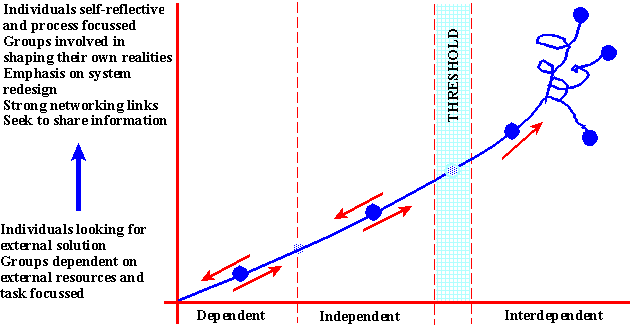CHAPTER 9
CHAPTER 9
Helping groups to learn enthusiastically -- roles for information, the Internet, and agency support
[Chapter 9 in: Allen, W.J. webmanager (at) learningforsustainability.net (2001) Working together for environmental management: the role of information sharing and collaborative learning. PhD (Development Studies), Massey University.]
Time period in which main work on this issue carried out:
| |||||||||||
| Jul- 94 | Jan- 95 | Jul- 95 | Jan- 96 | Jul- 96 | Jan- 97 | Jul- 97 | Jan- 98 | Jul- 98 | Jan- 99 | Jul- 99 | Jan- 00 |
Allen, W., Bosch, O., Kilvington, M., Oliver, J.& Gilbert, M. (2000) Benefits of collaborative learning for environmental management: Applying the Integrated Systems for Knowledge Management approach to support animal pest control.Journal of Environmental Management27(2): 215-223 *
This chapter looks more closely at the application of ISKM through a case study to improve the use of information within bovine Tb vector control, paying particular attention to the lessons that emerged within different steps. Some considerations about the growing role of, and potential for, using groups as a mechanism to manage and foster change in natural resource management are highlighted. The role of social capital (social networks, norms and trust) in supporting the process of learning is highlighted, and a model is presented to categorise group development in these terms. The accompanying paper draws attention to different approaches to extension, and how their use in practice should often be seen as complementary. The third version of ISKM is presented, emphasising the need to put more effort into building relationships and clarifying goals as a starting point for collaborative initiatives. Finally the paper looks more closely at the potential role of the Internet in supporting information management and networking. The need for action researchers to learn lessons across case studies and programmes is also noted.
The reflective material presented in this thesis aligns with the dual aims of the research outlined above. The accompanying chapter paper focusses on how to improve the provision of and access to sound information repuired for decision-making, and was finalised as a collaborative reflective exercise following the completion of this case study. This not only involved Ockie Bosch, Margaret Kilvington and myself as researchers, but also brought in the perspectives of John Oliver (AHB) and Malcolm Gilbert (farmer and Chair, North Canterbury Tb Management Committee). Of equal importance to the lessons being developed through this paper were the findings related to group motivation contained in an accompanying report (Kilvington, Allen & Kravchenko 1999. Improving farmer motivation within Tb vector control. Landcare Research Contract Report LC9899/110) which was written as a result of work done in the second phase of this project, and is included within this thesis as Appendix II.
As indicated earlier, what can be usefully regarded as the third and most current version of ISKM is illustrated in both Chapter 8, Figure 8.1 and in this chapter as Figure 9.5. They differ slightly in that the version presented in this chapter has only 4 steps, reflecting that in many ways the act of getting people to provide information can be thought of as part of the community dialogue/collaborative planning process. Moreover, the accompanying chapter paper explores what is involved in each of the ISKM steps in much more detail than was provided in the Chapter 8 paper.
The paper begins with a discussion of the challenges facing extension, in its wider sense as '... the science of the planned change of voluntary decisions through information systems' (Rolings 1988 p. ix). This discussion acknowledges that there are a number of different extension approaches (Figure 9.1).

Figure 9.1 Complementarity of differing extension paradigms ( Adapted from Coutts 1994 sourcing Van Beek & Coutts 1992). The area being discussed in this thesis is shown as shaded.
Accordingly, this helps us see that the use of linear TOT approaches to extension are not necessarily 'wrong'. There are very clear examples where this approach to technology transfer is highly successful. It does mean that we must recognise a continuum of extension paradigms. A useful framework has been proposed by Bloome (1991 quoted in Coutts 1994 pp. 5-6). His proposal was that extension can be classified under four paradigms: technology transfer; problem solving (or consultancy); informal education (or collaborative learning); and human development (Figure 9.1). Further, Bloome sees these differing views as complementary, rather than in conflict -- each relevant to different needs and situations.
The major evolution of ISKM highlighted in this paper, compared to the second version (Figure 5.7), is the much greater emphasis put on the need to build relevance, trust and a constructive climate for change from the beginning of any collaborative project. It suggests that this involves a number of steps including identifying and involving relevant people, building relationships, and establishing the ground rules for working together. While the other steps remain essentially the same, this case study provides for an improved understanding of what is involved in the implementation of ISKM as a whole, and more ideas of how the implementation of each of the steps can be improved.
The importance of seeing information as part of a wider social system was highlighted by an evaluation exercise run at the beginning of the research programme. In this evaluation the local Tb Management Committee were asked to identify the activities they felt were crucial if the Tb problem was to be effectively addressed. The subsequent diagram (Figure 9.2) and discussion confirmed the relevance of this project, and others related to information management and sharing, to a range of representatives working in related areas of bovine Tb control (Allen & Bosch 1998). It clearly recognises the role of current management and related research efforts into both disease and vector control (the shaded area). At the same time, it highlights the need to address many of the challenges to providing good information within a more effective collaborative learning environment.

Figure 9.2 Goals that a successful programme to manage bovine Tb needs to achieve (edited diagram from North Canterbury Tb Management Committee meeting 15/5/97).
A number of goals identified in the above diagram related to the need for improved communication, learning and information/technology transfer and exchange. These, in turn were felt necessary to lead to changed behaviour 'on the ground' in the form of integrated farm management that takes account of the need to include Tb vector control. As one farmer said: 'We need to get farmers to realise that they need to maintain their efforts into vector control, in the same way that they need to maintain their efforts into drenching the hoggets.'
What participants in this evaluation also noted, however, was that although these latter areas are all seen as vitally important, little is known, and little research is carried out on how to set goals and action plans and monitor achievements. In turn, because it is hard to specify the necessary actions and their resulting outputs in quantitative terms, it is difficult to write objectives and allocate money for activities (e.g. summarising information through pamphlets, motivating farmer group members). Newsletters, field days and late-night phone calls are essential activities, but because outputs are hard to quantify, these tend to be omitted from formal operating plans, and consequently remain largely underfunded. Much voluntary effort is expended in these activities.
The need to bring together and structure information from different sources so that it is more easily accessible was clearly identified. Developing improved monitoring systems for both disease and vector control was another area seen as vital. Although it was recognised that much data (particularly related to disease monitoring) are being collected, participants felt that more effort was needed to structure the results and make them more widely available to help different decision-makers. Collectively the points made by participants at this evaluation helped confirm the relevance for the research initiative outlined here. Also, the fight against bovine Tb provides a good example of how contemporary programmes in resource management will increasingly involve different interest groups and agencies working in co-operation on several closely linked fronts.
As we (the researchers) moved on to stages of information gathering and community dialogue, we could also begin to see the potential for using multiple case studies within a wider action research cycle to draw out broader and more robust experiential lessons (Figure 9.3). For example, in the HMP case study introduced in Chapter 3, we suggested that 'beginning with local knowledge of management goals, problems was an important starting point' for accessing existing knowledge. In this second case study we had the opportunity to 'test' this generalisation in a different setting by starting with science knowledge. However, as documented in the paper we found that this provided a narrower context for guiding 'best management practice' than was required in practice.

Figure 9.3 Use of expanded action research cycles to learn lessons across case studies.
This work also provided additional thoughts (to complement similar Internet initiatives concurrently undertaken in the tussock grasslands) regarding the potential role of the Internet to help leverage the improvement of information management within natural resource management. It was interesting that while scientists generally appeared to see the use of web-based information as yet one more way of 'getting the right information out there', a number of farmer group leaders indicated that their 'vision' of the Internet was as a focal point around which to build more opportunities for farmer- scientist discussion and learning. Some group leaders and facilitators also recognised the need for Internet-based material to provide a community resource which could be easily updated, and shared with other farmers -- who may not have Internet access -- through their involvement with groups.
Moreover, while scientists involved in pest management saw the development of 'best practice' guidelines for pest control as a technical question, the farmer group leaders saw 'best practice' as a twofold question encompassing both technical issues (strategies for pest control) and social issues (how we get people to do the work). This latter point also raised wider questions about the growing role of, and potential for, using groups as a mechanism to manage and foster change in natural resource management. Many factors are driving this shift. A predominant one is that many tasks (such as reducing ferrets in a locality) are just too big for individuals to handle alone. Another is the recognition that groups can be more effective in solving problems and learn more rapidly than individuals. However, while groups may be an essential ingredient within natural resource change efforts, their presence certainly does not guarantee success.
In turn, these questions were the catalyst for a second focus of work within this project, which looked at how the Animal Health Board (AHB) can improve farmer motivation, with particular emphasis on how this can be achieved through LIP (Local Initiative Programme) farmer-based vector control groups. The ensuing report (Kilvington et al. 1999 reproduced here as Appendix II) looks more closely at motivation and identifies the use of well-managed and supported farmer groups as a leverage point for improving farmer participation in ferret control activities. It suggests that these groups have the potential to harness the positive aspects of social pressure and provide a vehicle for improved information sharing, collaboration, motivation and networking.
Frequently, elements such as motivation, information and learning are only associated with voluntary policy approaches. However, as this report notes, these linked support-approaches can equally be seen as making a significant contribution to reinforce other policy mechanisms including regulation and economic-based incentives/disincentives. Other issues relating to the successful support of group-based approaches identified here include: awareness of what is happening to a group, understanding of a group's needs for resources and leadership, and access to the skills necessary to address this. Moreover, as outlined in Chapter 5, encouraging people and groups to participate in monitoring their own progress in these areas and evaluating achievements is a way of strengthening motivation as well as improving how they work together and build relationships for change.
In the development and organisational learning literature the social networks, norms and trust which facilitate this co-operation for mutual benefit are referred to as 'social capital' (e.g. Schuller & Field n.d.; Baker n.d.; Pretty & Frank 2000). Tom Schuller and John Field paraphrase Coleman in highlighting the links between social capital (i.e. relationships) and learning:
As developed by James Coleman and others, the idea of social capital has come to play an important role in helping explain educational attainment (Coleman 1988, Coleman 1994). For Coleman, the concept of social capital complements that of human capital; indeed, it helps explain variations in the levels of human capital in any given society. Coleman's conclusion is, briefly, that high levels of human capital tend to arise when individuals can draw on 'the set of resources that inhere in family relations and in community social organisation and that ..... can constitute an important advantage for children and adolescents in the development of their human capital' (Coleman 1994: 300). This is an appealing conclusion, not least because it directs attention to such 'soft' variables as social networks and values, rather than focusing primarily upon the 'hard' variables that tend to form the bedrock of human capital thinking. (Schuller & Field n.d.).
The literature relating to social capital and development is extensive, and further examination of this is beyond the scope of this thesis. However, from this brief discussion we can see social capital as the framework that supports the process of learning through interaction. A key requirement for social capital to be present is the formation of networking paths that are both horizontal (across agencies and sectors) and vertical (agencies to communities to individuals). The quality of the social processes and relationships that social capital supplies -- within which learning interactions take place -- is especially influential on the quality of the learning outcomes in collaborative approaches.
It was clear from our work in this project that many groups measured their team performance outlined almost specifically in relation to their ability to deliver on the main goal of controlling Tb vectors. However, as Kilvington et al. 1999 Appendix II point out, this emphasis on the bigger goal tended to obscure the less obvious measures of success that groups had achieved along the way both in terms of tasks (smaller on-the-ground activities) and process (their development in managing and improving the way the members worked together).
In particular, we need to remember that it is these latter process issues -- including the development of social capital -- that are key to the long-term survival of groups. Some will become highly effective, growing and diversifying their activities to better support the wider aims of sustainability, while others will either cease after completing a specific task, or struggle on in name only. The following model (Figure 9.4) illustrates one way of categorising group process development. Teams at later stages (towards the right of the diagram) are taken to be more resilient and more adaptive -- capable of contributing to the innovations desired for social and institutional culture change (e.g. improved environmental understanding and management). All stages relate measures of group or individual status to performance or outcomes.

Figure 9.4 Stages in group maturity (adapted from Pretty & Frank 2000).
As Pretty & Frank (2000) explain, this model of group stages is essentially progressive, indicating that one stage can lead to another. Progression, though, is not taken as inevitable, with outcomes at any point leading to the group moving on, going back to a previous phase, or staying in one place. These authors go on to define each group in terms of a number of identifying characteristics.
The dependent phase can often be seen when individuals agree to form a group, often in response to a crisis or prompting (from management). They can see benefits in working as a group, but are likely to spend much of their time looking back at what has happened, rather than forward. Individuals are still likely to be looking for external solutions (albeit new ones) so dependency remains high, particularly on external consultants and resources. They are task focussed, measuring success by 'getting the job done'.
The second phase sees growing independence, combined with a realisation of new emerging capabilities. Members are increasingly willing to invest their time in the group itself as trust grows, although the focus is still on task rather than process. At this stage groups are likely to develop links with internal and outside groups. This is a stronger and more resilient group stage, but is still likely to break down once members feel they have achieved their original aims.
The final phase illustrates a turning point for groups or teams, where they are much more aware of the value of the group itself and its capabilities to problem-solve. Individually, members will be characterised by the development of capacities which expect change, are more dynamic, and capable of developing responses to help shape a desired future. Individuals, in this sense, can be seen to have changed -- taking a different approach to looking at, and addressing, perceived problems. This change is represented in the above diagram by the shaded threshold area. Groups in this phase will not only focus on task issues but will place an equal emphasis on process. In regard to this latter point group members will continually look to ways of strengthening themselves as a team, and be quite critically evaluative of their own abilities. Groups in this phase will be capable of promoting the spread of appropriate technologies and ideas to other groups, and of initiating new groups themselves. They will be increasingly linked to a range of external alliances.
As Morgan (1999) points out, the tension between building task and process orientation runs through most efforts at development cooperation: 'Many programs tend to oscillate from one perspective to the other, first emphasizing task achievement and the production of program benefits -- getting the job done -- and then swinging back to a process effort in order to develop more capacity in relation to process issues. Getting the right interrelationship between achieving task benefits and developing effective and sustainable capacity to make the process ongoing is crucial' (Morgan 1999). Equally, as environmental research and development initiatives begin to consider process as well as task issues, similar tensions will have to be addressed.
See also the following paper which represents the remainder of this chapter: Allen, W., Bosch, O., Kilvington, M., Oliver, J.& Gilbert, M. (2000) Benefits of collaborative learning for environmental management: Applying the Integrated Systems for Knowledge Management approach to support animal pest control. Journal of Environmental Management27(2): 215-223 *
* This paper was originally submitted in the dissertation as "in press".
| <<< BACK | CONTENTS | NEXT >>> |
| Back to Learning for Sustainability research index This site is compiled and maintained by Will Allen (PhD) (webmanager (at) learningforsustainability.net ) |



Komentar
Posting Komentar